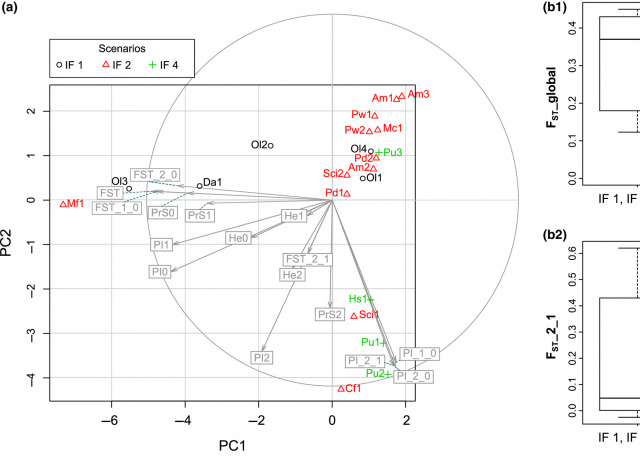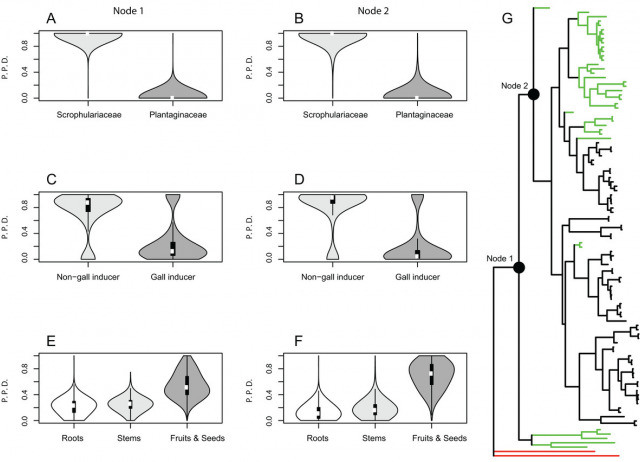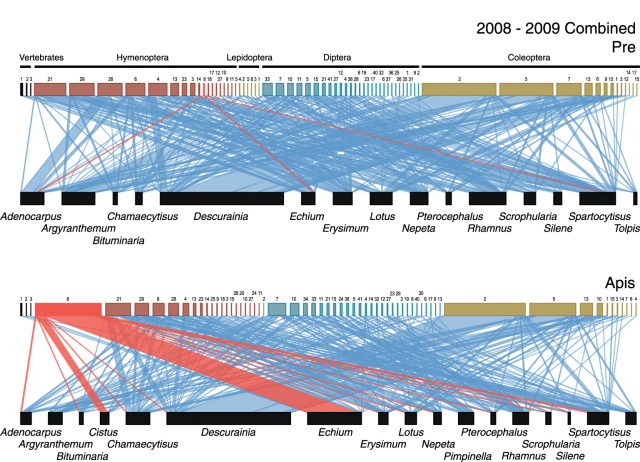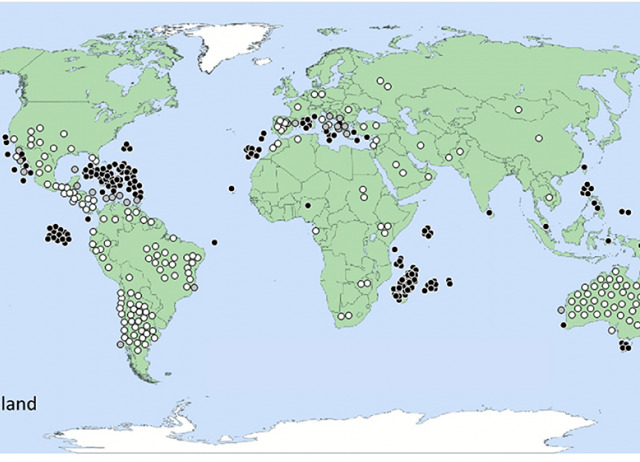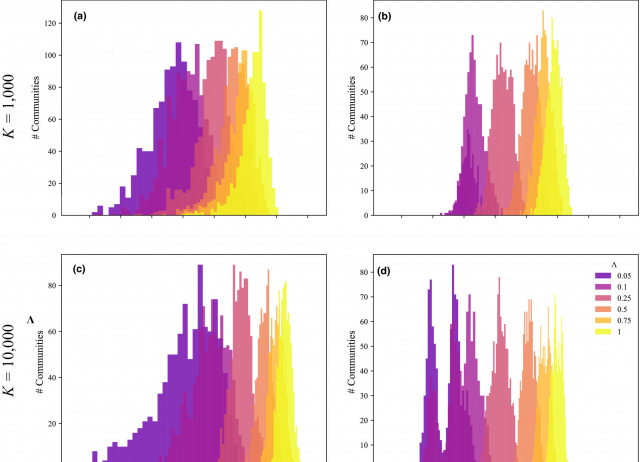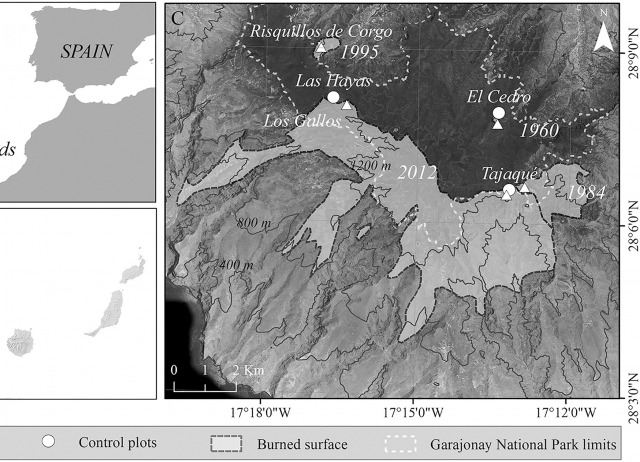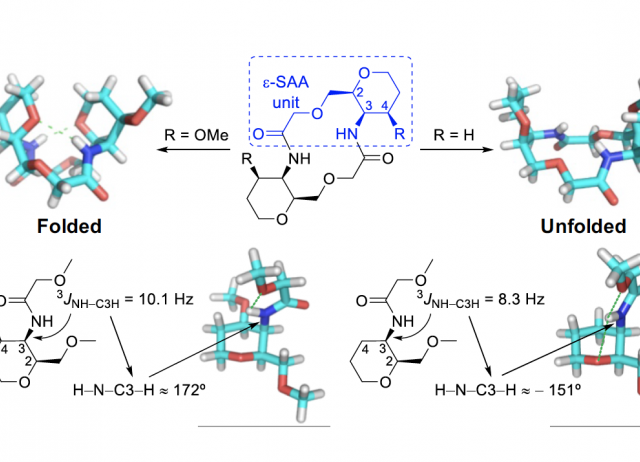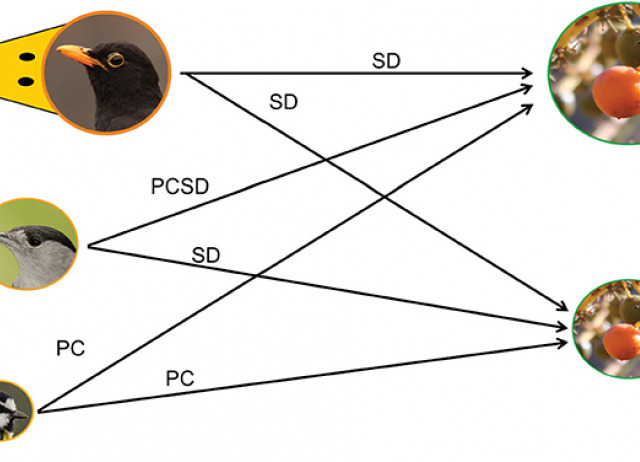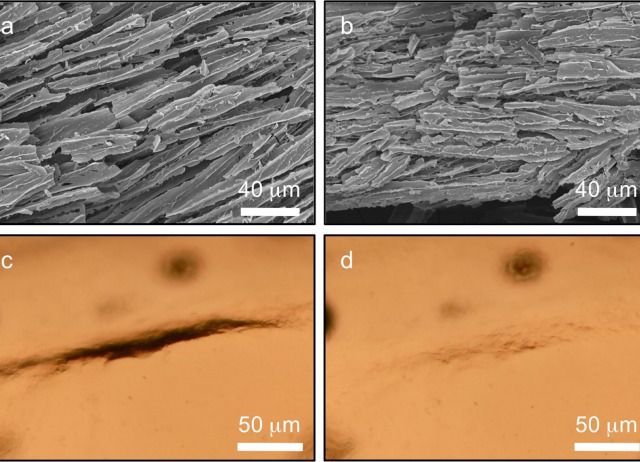
Polymer topology-controlled self-healing properties of polyelectrolyte hydrogels based on DABCO-containing aromatic ionenes
DABCO-containing polymers based on a disubstituted phenylene dibenzamide core constitute versatile gelators enabling the formation of hydrogels for different applications. In this work we have found that the polymer topology, controlled by the disubstitution pattern of the aromatic core, plays a crucial role on the self-healing properties of the corresponding hydrogels. Specifically, the ortho-isomer showed very superior shape persistent, self-standing and self-healing properties compared to its meta- and para-analogues. Interestingly, the healing process occurred without the need of involving oppositely charged species.
Häring, Marleen; Grijalvo, Santiago ; Haldar, Debasish; Saldías, César; Díaz Díaz, David
No borders during the post-glacial assembly of European bryophytes
Climatic fluctuations during the Last Glacial Maximum (LGM) exerted a profound influence on biodiversity patterns, but their impact on bryophytes, the second most diverse group of land plants, has been poorly documented. Approximate Bayesian computations based on coalescent simulations showed that the post-glacial assembly of European bryophytes involves a complex history from multiple sources. The contribution of allochthonous migrants was 95–100% of expanding populations in about half of the 15 investigated species, which is consistent with the globally balanced genetic diversities and extremely low divergence observed among biogeographical regions. Such a substantial contribution of allochthonous migrants in the post-glacial assembly of Europe is unparalleled in other plants and animals. The limited role of northern micro-refugia, which was unexpected based on bryophyte life-history traits, and of southern refugia, is consistent with recent palaeontological evidence that LGM climates in Eurasia were much colder and drier than what palaeoclimatic models predict.
Ledent, A.; Désamoré, A.; Laenen, B.; Mardulyn, P.; McDaniel, S.F.; Zanatta, F.; Patiño, Jairo; Vanderpoorten, A.
Evolution of host plant use and diversification in a species complex of parasitic weevils (Coleoptera: Curculionidae)
Weevils (Coleoptera: Curculionoidea) represent one of the most diverse groups of organisms on Earth; interactions with their host plants have been recognized to play a central role in their remarkable diversity, yet the exact mechanisms and factors still remain poorly understood. Using phylogenetic comparative analyses, here we investigate the evolution of host use and its possible role in diversification processes of Rhinusa and Gymnetron, two closely related groups of weevils that feed and develop inside plant tissues of hosts within the families Scrophulariaceae and Plantaginaceae. We found strong evidence for phylogenetic conservatism of host use at the plant family level, most likely due to substantial differences in the chemical composition of hosts, reducing the probability of shifts between host families. In contrast, the use of different plant organs represents a more labile ecological trait and ecological niche expansion that allows a finer partitioning of resources. Rhinusa and Gymnetron weevils initially specialized on plants within Scrophulariaceae and then shifted to the closely related Plantaginaceae; likewise, a gall inducing behavior evolved from non-galler weevils, possibly in response to resource competition, as galls facilitate larval development by providing enhanced nutrition and a favorable microhabitat. Results from trait-dependent diversification analyses suggest that both use of hosts within Plantaginaceae and parasitism on fruits and seed capsules are associated with enhanced diversification of Rhinusa and Gymnetron via low extinction rates. Our study provides quantitative evidence and insights on the ecological factors that can promote diversification in phytophagous insects that feed and develop inside plant tissues.
Hernández-Vera, Gerardo; Toševski, Ivo; Caldara, Roberto; Emerson, Brent C.
Honeybees disrupt the structure and functionality of plant-pollinator networks
The honeybee is the primary managed species worldwide for both crop pollination and honey production. Owing to beekeeping activity, its high relative abundance potentially affects the structure and functioning of pollination networks in natural ecosystems. Given that evidences about beekeeping impacts are restricted to observational studies of specific species and theoretical simulations, we still lack experimental data to test for their larger-scale impacts on biodiversity. Here we used a three-year field experiment in a natural ecosystem to compare the effects of pre- and post-establishment stages of beehives on the pollination network structure and plant reproductive success. Our results show that beekeeping reduces the diversity of wild pollinators and interaction links in the pollination networks. It disrupts their hierarchical structural organization causing the loss of interactions by generalist species, and also impairs pollination services by wild pollinators through reducing the reproductive success of those plant species highly visited by honeybees. High-density beekeeping in natural areas appears to have lasting, more serious negative impacts on biodiversity than was previously assumed.
Valido, Alfredo; Rodríguez-Rodríguez, María C.; Jordano, Pedro
Frugivory and seed dispersal by lizards: A global review
Birds and mammals are the only vertebrates which receive comprehensive attention in studies of dispersal of fleshy-fruited plant species. However, recently the importance of fleshy fruit in the diet of lizards (order Squamata: suborder Sauria), and their role as seed dispersers have been recognized in a number of studies, especially in studies from arthropod-poor habitats, such as oceanic islands. Here, we revisit the evidence of fruit-eating lizards on a global scale in order to test if fruit consumption is more common on islands than expected by chance. We constructed a database of 470 lizard species (from a global count of 6,515 species), that have been reported to consume fleshy fruits. This set of lizards belong to 27 families with Scincidae (N = 78 species), Gekkonidae (69), and Dactyloidae (55) having more frugivorous species than other lizard families. We found that 62.4% of these lizards inhabit islands, whereas only one third (35.3%) of all lizard species inhabit islands. These values support the presence of an >insular phenomenon,> however; we also tested if this biogeographical pattern might be driven by body size and evolutionary history of lizards. Thus, we looked for any phylogenetic signals in the distributions of lizard body size, island-presence, and frugivory and calculated phylogenetically corrected correlations among the three variables on a global subset of 2,417 lizard species for which we had detailed phylogenetic information. Both lizard body size and island-presence were weakly influenced by phylogeny; whereas, frugivory was not. In addition, we found that (1) body size and frugivory were weakly positively correlated; (2) body size and island-presence were uncorrelated; and (3) island-presence and frugivory were strongly positively correlated. Thus, we conclude that the main driver of frugivory on islands is the specific island environment and not lizard body size per se. Islands are said to be poor in arthropods and predators, and this may force/allow island lizards to forage for additional food sources, such as fleshy fruits. We also suggest that modern lizards as well as their ancestors may potentially play an important role to many plants as seed dispersers. However, we do not known how tight the correlation is between frugivory and seed dispersal. Thus, lizards repeatedly inspire us to ask new ecological and evolutionary questions.
Valido, Alfredo; Olesen, Jens M.
An integrated model of population genetics and community ecology
Quantifying abundance distributions is critical for understanding both how communities assemble, and how community structure varies through time and space, yet estimating abundances requires considerable investment in fieldwork. Community-level population genetic data potentially offer a powerful way to indirectly infer richness, abundance and the history of accumulation of biodiversity within a community. Here we introduce a joint model linking neutral community assembly and comparative phylogeography to generate both community-level richness, abundance and genetic variation under a neutral model, capturing both equilibrium and non-equilibrium dynamics, [Location]: Global, [Methods]: Our model combines a forward-time individual-based community assembly process with a rescaled backward-time neutral coalescent model of multi-taxa population genetics. We explore general dynamics of genetic and abundance-based summary statistics and use approximate Bayesian computation (ABC) to estimate parameters underlying the model of island community assembly. Finally, we demonstrate two applications of the model using community-scale mtDNA sequence data and densely sampled abundances of an arachnid community on La Réunion. First, we use genetic data alone to estimate a summary of the abundance distribution, ground-truthing this against the observed abundances. Then, we jointly use the observed genetic data and abundances to estimate the proximity of the community to equilibrium, [Results]: Simulation experiments of our ABC procedure demonstrate that coupling abundance with genetic data leads to improved accuracy and precision of model parameter estimates compared with using abundance-only data. We further demonstrate reasonable precision and accuracy in estimating a metric underlying the shape of the abundance distribution, temporal progress towards local equilibrium and several key parameters of the community assembly process. For the insular arachnid assemblage, we find the joint distribution of genetic diversity and abundance approaches equilibrium expectations, and that the Shannon entropy of the observed abundances can be estimated using genetic data alone, [Main conclusions]: The framework that we present unifies neutral community assembly and comparative phylogeography to characterize the community-level distribution of both abundance and genetic variation through time, providing a resource that should greatly enhance understanding of both the processes structuring ecological communities and the associated aggregate demographic histories.
Overcast, Isaac; Emerson, Brent C.; Hickerson, Michael J.
Short- and long-term effects of fire in subtropical cloud forests on an oceanic island
The recurrence of fires has increased considerably due to human activity, affecting even forests where traditionally fire is uncommon. In this study, we verify the effects of degradation caused by fire in the Canarian laurel forests, which is a subtropical forest formation restricted to the humid montane areas of these Macaronesian islands. We evaluated the effect of fire by comparing a series of burned plots corresponding to fires from 1960, 1984, 1995, to 2012 with geographically proximate and comparable unburned plots in the Garajonay National Park (La Gomera Island, Spain). We focused on three aspects that are immediately altered by fire: forest structure, floristic composition, and microclimate. These aspects have been quantified using (a) tree density, the Pielou index using tree height classes, and DBH for the vertical structure of the forest; (b) DCA, the Bray Curtis dissimilarity index, and a species indicator analysis for the floristic composition; and (c) temperature and relative humidity for microclimate under three canopy cover conditions. Our results reveal that, overall, structural complexity and its composition in the burned areas have barely reached 40% and 35%, respectively, when compared with unburned areas, and recovery mainly depends on time since fire. Additionally, burned plots presented more pioneer species, a higher density of trees, and climatic variables tend to have a wider range throughout the day. These data reveal the long time span that this ecosystem needs for recovery to a prefire state and how it may be more prone to subsequent fire events.
Bello-Rodríguez, Victor; Gómez, Luis A.; Fernández López, Ángel; Del-Arco-Aguilar, Marcelino J.; Hernández-Hernández, Raquel; Emerson, Brent C.; González-Mancebo, Juana María
A Domino Strategy for the Synthesis of 2H‐Pyrans from Propargyl Vinyl Ethers
Stable monocyclic 2H‐pyrans are synthesized from readily available tertiary propargyl vinyl ethers via a metal‐free all‐pericyclic domino manifold involving a sequential propargyl Claisen rearrangement/[1,3]H‐shift/oxa‐6π electrocyclization set of reactions. The wide scope of this protocol is exemplified by the synthesis of 21 different 2H‐pyrans incorporating a varied substitution pattern at the ring.
Tejedor, David; Delgado-Hernández, Samuel; Diana-Rivero, Raquel; Díaz-Díaz, Abián; García-Tellado, Fernando
Conformational Control of Tetrahydropyran-Based Hybrid Dipeptide Catalysts Improves Activity and Stereoselectivity
Herein, we introduce and demonstrate how carbohydrates can be used as conformational control units of organocatalysts to tune their catalytic properties. New hybrid dipeptide-like organocatalysts based on ζ-sugar aminoacids and proline were prepared and tested for the asymmetric Michael addition of aldehydes to β-nitrostyrenes. Taking full advantage of the modular nature of the carbohydrate motif, both reactivity and stereoselectivity were significantly improved. By simple structural changes, such as the elimination of the methoxy group in the C4 position of the tetrahydropyran ring, we obtained two complementary catalysts that allow access to both enantiomers of the γ-nitroaldehydes with excellent yields, diastereoselectivity, and enantiomeric excesses between 97 and 99%, using a catalytic load even below 1 mol%.
Borges-González, Jorge ; García-Monzón, Irma; Martín, Tomás
Unraveling the seed dispersal system of an insular "ghost" dragon tree (Dracaena draco) in the wild
Despite being abundant in urban gardens, the Canary Islands dragon tree Dracaena draco is close to extinction in the wild. It tends to produce relatively large fruits, which limits the pool of vertebrates that might disperse its seeds. We aimed to shed light on the seed dispersal system of this plant by studying its fruit size in relation to the feeding behavior of its present dispersers, and to discuss on possible differences with the past dispersal system, when large-sized dispersers were abundant. Besides fruit and seed characterization, we performed experiments on seedling emergence (using the characterized seeds), and field observations of the fruit handling behavior of frugivorous birds. Seed removal by granivores beneath and outside the dragon tree canopies was assessed through a field experiment. An additional seedling emergence experiment tested the effect of pulp removal from around the seed (using seeds contained within the fruits and manually depulped seeds). A feeding experiment was carried out with captive individuals of the Canary endemic white-tailed pigeon Columba junoniae-a large frugivore that occasionally consumes D. draco fruits-to test if its gut treatment influences seed viability. Small fruits produced seeds unable to germinate, while most seedling emergence was recorded only for seeds from large fruits. Our observations suggest that the only passerine species able to swallow large fruits is the medium-size passerine Turdus merula, whereas small passerines tended to pluck the pulp without aiding seed dispersal. Nonetheless, Sylvia atricapilla-the largest among the group of small passerines-occasionally transported fruits away from parent plants to consume the pulp, resulting in seed dispersal without any digestive treatment. This behavior indicates S. atricapilla might be occasionally a legitimate disperser of D. draco, since our experiments suggest that seed transport away from parent trees and pulp removal enhance both post-dispersal seed survival and seedling emergence. Lastly, the pigeons used in the experiment regurgitated mostly viable seeds, suggesting the legitimacy of C. junoniae as seed disperser for D. draco. Therefore, although D. draco likely had more seed dispersers in the past, we identified at least two bird species that can still disperse its seeds nowadays.
González-Castro, Aarón; Pérez-Pérez, David; Romero, Javier; Nogales, Manuel
